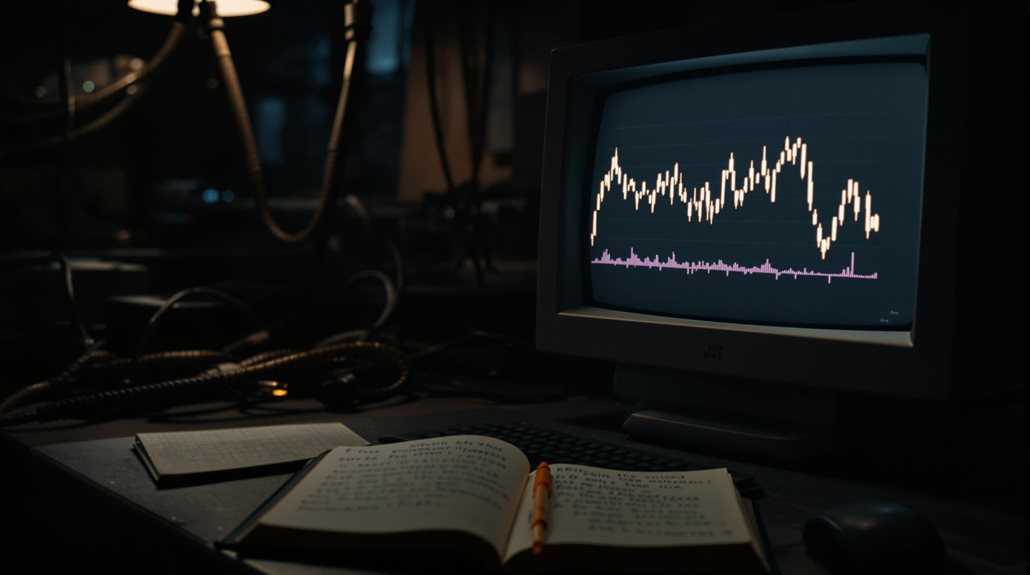Bitcoin started with no monetary value when it launched in January 2009. The first recorded price emerged on October 5, 2009, when 1,309.03 BTC equaled one U.S. dollar. The first real sale happened a week later, with 5,050 BTC selling for $5.02 via PayPal, valuing each Bitcoin at about $0.0009. From these humble beginnings, Bitcoin's value has experienced dramatic changes throughout its history, with fascinating developments along the way.

When Bitcoin first launched in January 2009, it didn't have any price at all. Created by someone using the name Satoshi Nakamoto, Bitcoin started as an experiment in digital currency with no real market value. The first Bitcoin transaction happened on January 12, 2009, when Satoshi sent 10 BTC to Hal Finney, but there wasn't any dollar value attached to this transfer.
Bitcoin's first recorded price emerged on October 5, 2009, when someone set up an exchange rate that valued 1,309.03 BTC at one U.S. dollar. Shortly after, on October 12, 2009, a Finnish developer made the first real sale, trading 5,050 BTC for $5.02 through PayPal. This transaction valued each Bitcoin at less than a penny – about $0.0009 per coin. IBM and Goldman Sachs made significant investments in blockchain technology, helping to establish Bitcoin's legitimacy in its early days.
The first notable real-world purchase came in May 2010, when someone bought two pizzas for 10,000 BTC. This famous pizza transaction set an informal exchange rate of $0.0025 per Bitcoin. Later that year, Bitcoin's price started gaining momentum, breaking past 10 cents in October 2010. The upward trend continued, and Bitcoin reached $1 for the first time on April 13, 2011. By June 2011, the price had surged dramatically to nearly $30. The Genesis Block was mined on January 3, 2009, marking the official beginning of Bitcoin's journey.
Bitcoin's price journey became even more interesting in 2013 when it broke through both the $100 and $1,000 marks. In December of that year, it reached a peak of $1,242, showing just how far it had come from its nearly worthless beginning. After this surge, the price settled down, spending most of 2015 hovering around $200.
The start of 2016 marked the beginning of a new chapter in Bitcoin's price history. The cryptocurrency was designed with a maximum supply of 21 million coins to ensure scarcity and value. From there, the cryptocurrency commenced on a remarkable upward trajectory that would eventually lead to its all-time high of $76,999 in November 2024. This dramatic rise represents an incredible journey from Bitcoin's humble beginnings when it had no price at all.
Looking back at Bitcoin's price history shows how it transformed from a digital experiment with no monetary value into a globally recognized asset worth tens of thousands of dollars. While the early days saw Bitcoin trading for fractions of a penny, its value has increased dramatically since those first transactions in 2009.
Frequently Asked Questions
How Long Does It Take to Mine One Bitcoin?
The time to mine one Bitcoin varies widely based on mining power.
With a single ASIC miner, it could take years or even decades. Medium-sized operations with 100 ASIC miners might take around 68 days, while large mining farms with 1,000+ machines can mine one Bitcoin in days or weeks.
Most miners join mining pools to receive smaller, more frequent payouts instead of waiting to mine a full Bitcoin.
Can You Lose Money if Bitcoin Crashes?
Yes, it's definitely possible to lose money if Bitcoin crashes. The cryptocurrency's price changes a lot, sometimes dropping by 40% or more in a single day.
If someone buys Bitcoin and its value falls, they'll lose money if they sell at the lower price. Bitcoin's had many big crashes throughout its history.
While it's bounced back before, there's no guarantee it'll always recover. It's not protected by government insurance like bank accounts are.
Why Can't There Be More Than 21 Million Bitcoins?
Bitcoin's 21 million limit is hardcoded into its software, like a rule that can't be easily changed.
It's similar to how there's only a certain amount of gold on Earth. The limit exists because Bitcoin's creator wanted to make it scarce and prevent inflation.
To change this limit, most Bitcoin users would need to agree, but they're unlikely to do so because it would hurt Bitcoin's value and go against its original design.
Which Country Owns the Most Bitcoin?
Based on government holdings, the United States owns the most Bitcoin with approximately 215,000 BTC. This makes it the largest government holder of Bitcoin worldwide.
While India has the most individual Bitcoin owners (85.5 million people), when it comes to official government holdings, the US leads by a large margin.
Ukraine follows in second place with 46,351 BTC, and El Salvador ranks third with 5,690 BTC in government holdings.
What Happens to Lost Bitcoin Wallets and Passwords?
Lost Bitcoin wallets and passwords can't be recovered without proper backup information.
When someone loses access to their wallet or forgets their password, those Bitcoin become permanently stuck and unusable.
It's estimated that around 1.57 million Bitcoin are lost forever.
This lost Bitcoin isn't destroyed – it still exists on the blockchain, but nobody can spend it.
These losses actually make the remaining Bitcoin more scarce and valuable.





